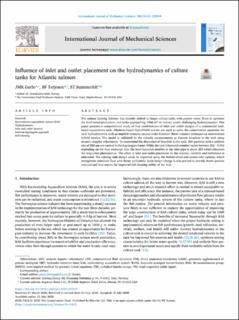| dc.contributor.author | Gorle, Jagan | |
| dc.contributor.author | Terjesen, Bendik Fyhn | |
| dc.contributor.author | Summerfelt, Steven T. | |
| dc.date.accessioned | 2020-08-24T08:13:26Z | |
| dc.date.available | 2020-08-24T08:13:26Z | |
| dc.date.created | 2020-08-12T09:37:17Z | |
| dc.date.issued | 2020 | |
| dc.identifier.issn | 0020-7403 | |
| dc.identifier.uri | https://hdl.handle.net/11250/2673496 | |
| dc.description.abstract | The salmon farming industry has recently shifted to larger culture tanks with greater water flows to optimize the land-based production, but tanks approaching 1000 m3 in volume create challenging hydrodynamics. This paper presents a computational study of four combinations of inlet and outlet designs of a commercial land-based aquaculture tank. Windows-based OpenFOAM solvers are used to solve the conservation equations for tank hydrodynamics with an implicit unsteady second-order Eulerian (finite volume) technique on unstructured hybrid meshes. The model is validated by the velocity measurements at discrete locations in the tank using acoustic doppler velocimetry. To understand the dispersion of biosolids in the tank, 500 particles with a uniform size of 200 µm are tracked in the Lagrangian frame. While the tank's Reynolds number varies between 2E6 - 3.5E6 depending on the flow exchange rate, the local Reynolds number at the inlet pipe is about 2E5 which discovers the drag-crisis phenomenon. The effect of inlet and outlet placement on the velocity, vorticity and turbulence is addressed. The existing tank design could be improved using the bottom-drain and corner-inlet options, which strengthens rotational flow with better uniformity. Such design change is also proved to provide better particle removal and thus ensure the improved self-cleaning ability of the tank. | |
| dc.language.iso | eng | |
| dc.title | Influence of inlet and outlet placement on the hydrodynamics of culture tanks for Atlantic salmon | |
| dc.type | Peer reviewed | |
| dc.type | Journal article | |
| dc.description.version | publishedVersion | |
| dc.source.volume | 188 | |
| dc.source.journal | International Journal of Mechanical Sciences | |
| dc.identifier.doi | 10.1016/j.ijmecsci.2020.105944 | |
| dc.identifier.cristin | 1822902 | |
| dc.relation.project | Norges forskningsråd: 237856 | |
| cristin.ispublished | true | |
| cristin.fulltext | original | |
| cristin.qualitycode | 1 | |
